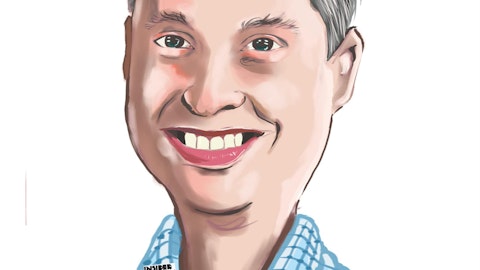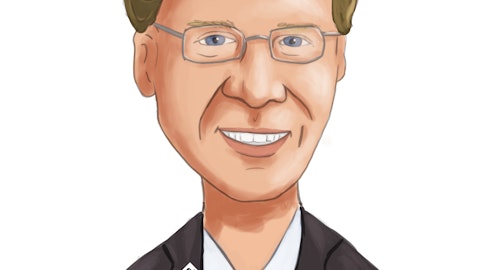Paul Walker: We are too. So, sorry, not to be €“ don’t mean to be €“ joke about that. But €“ so I think there are two different situations going on in China and Japan. First, I will start with Japan. Japan is, COVID has €“ like it has, largely in other places in the world, kind of run its course, come and gone. And what we are dealing with in Japan is just a slower than maybe even we would have expected return to normalcy there and expect that it will get back to where it was, but it’s going to be a slower climb back there than it has been in other parts of the world. What is a positive thing that may not be €“ it might not pick up immediately on in Japan, though is as €“ so, when we launched the All Access Pass 7 years ago in our English-speaking operations.
We did not launch right away in China or Japan. Part of that was for language reasons and there were some other reasons as well. And so they were later to the game. As Japan’s business have gone through COVID, coming back out the other side, the team there is now selling, substantially all of their business is being converted to All Access Pass business. So, that does actually mute a little bit their return because the stuff they are selling is being put out on the balance sheet, right. And so their business is rapidly becoming All Access Pass over the next couple of years. We believe that their All Access Pass as a percentage of their overall revenues will mirror that of what we are seeing in the U.S. and our English-speaking operations around the world.
And so that actually puts a little bit of an increased drag on the business as they come out of COVID. But long-term, it’s a really good thing because they €“ we would expect that they would enjoy the same type of growth rates and retention rates and things like that, that we have in other parts of the world. So, that’s the story on Japan. It will come back there. It is coming back and it’s being muted a bit because as it comes back, it’s being converted to subscription. China is a different deal. China went into COVID first 3 years ago, we all know that. They got COVID €“ because of their no-COVID policy, they got COVID back under control pretty quickly. And our business, which was hit hard early on, came roaring back and was roughly back to pre-pandemic levels a couple of years ago.
China went back into COVID 15 months or 18 months ago or so, and we have been dealing with that bumpiness and choppiness. It’s doubly difficult there right now, as you have probably seen in the headlines, as they have gone away from the no-COVID policy, and they basically have chosen to just let COVID kind of do its thing. Significant numbers of people are contracting COVID. At one point, our entire office in Beijing had COVID at the same time and without recovering from that. And so that’s happening all over the country right now. The death rate is quite high. And so that, I think you asked about when €“ I don’t know how to predict what that will look like, but I think it seems logical that, that will run its course over the next some number of months here, and then China ought to get back to some normalcy.
And what we have to point to there is when they had a handle on COVID the first time around, our business rebounded quite quickly and with back up to pre-pandemic levels within just a couple of quarters. So, I don’t know if that will be the pattern this time, but China and Japan are two different places. We do expect that they will continue to return. I think China will be hard for a good part of this year and we have tried to account for that in our expectations. But I think China will be slow this year.
Dave Storms: Very helpful. Thank you. If I could sneak one more in. You mentioned on Slide 14 kind of the transition that a subscription client has gone from roughly $40,000 a year to $77,000 a year. Can you go into a little more detail of what that transformation looks like and specifically what gross margins look like for our client as they go from their first year to second year and third year in the contract?
Paul Walker: Yes. So, great question. So, as we mentioned, typically, a client €“ that $40,000 of first year spend is comprised of what they spend for the All Access Pass subscription itself and then what they spend on the subscription services, the training, the facilitation, the coaching that we do. And so in rough terms, it’s about $27,000 of that first year spend is on the subscription itself for some defined population. They are buying a seat, a number of All Access Pass seats and the average amount totals to about $27,000. And then roughly another $13,000 in that first year of those subscription services we talk about. And then what happens is, is they are now a client of ours and they get access to €“ not only do they maintain access to their original client partner that sold the pass, but they now have access to a role that we call implementation strategist.
And that team together is now working to look for opportunities to expand that client relationship. And what you are seeing between the $40,000 first year spend and the average spend of $77,000 is just simply that €“ as those clients stay with us to mature, we are expanding to additional populations and then selling additional services as well. And all along the way, the blended gross margin on that business, the subscription and the services, is roughly 85%. So, it’s a function of these €“ of our land-and-expand model. And the good thing about our model, I think it’s a good thing, is that even in landing, we are landing a fairly sizable chunk. Where others land, it’s a credit card swipe for a couple of people, right, for a technology purchase.
And then you are hoping to expand usage of something from a couple of people to something larger. We are landing much more significant initial populations than expanding from there.





